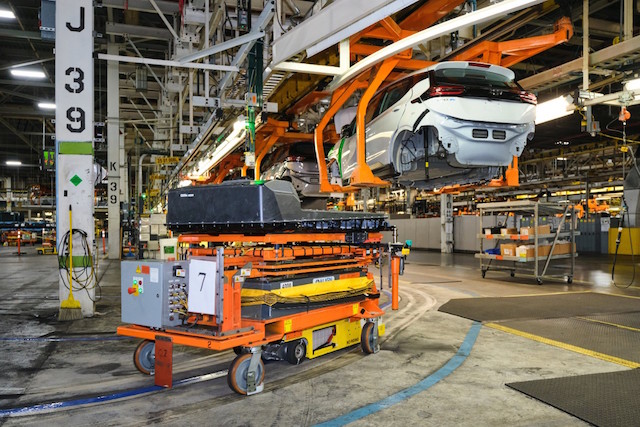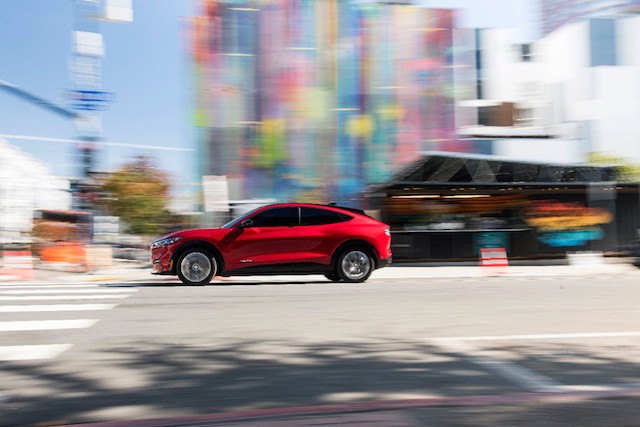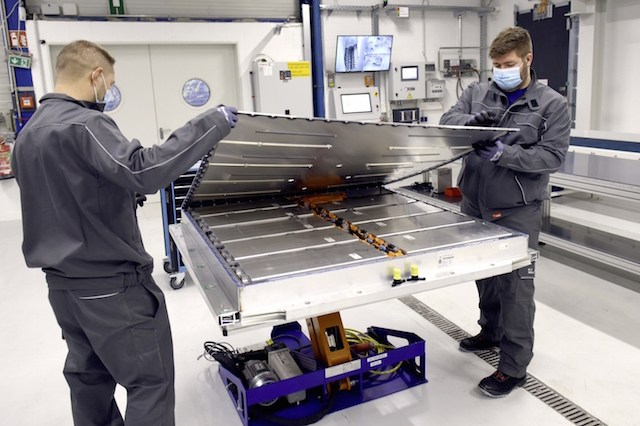Few would argue electric vehicles aren’t without their faults – they’re often expensive, take time to charge, etc. Their positive effect on the environment, however, is rarely brought into question.
The presence of an electric-powered battery instead of an internal combustion engine allows these cars to roam the roadways without producing any harmful tailpipe emissions. But between manufacturing, charging and recycling them, these batteries may not be as green as they seem. It begs the question: Are electric car batteries bad for the environment?
Let’s follow an electric car battery through its life cycle to see where it’s helping the environment and where it’s not.

Raw Materials
The environmental toll of electric car batteries begins before the product is even assembled, most notably in the mining of its active material, lithium. To extract lithium from the earth, an immense amount of water is pumped down into salt flats, bringing mineral-rich saltwater to the surface. Lithium is filtered out of the mixture left behind after the water evaporates.
This water-intensive process is problematic for several reasons, including its potential to contaminate the water supply. Further complicating the issue is the location of these mines, many of which are found in desert regions of Australia and China. More than half the planet’s lithium supply, however, is in an area called the Lithium Triangle, spanning Andean Mountain sections of Argentina, Bolivia and Chile. The area is one of the driest places on the globe, and lithium mining consumes as much as 65% of the region’s water, according to the United Nations.
Lithium isn’t the only potentially hazardous electric vehicle battery material. The process of mining for cobalt, the majority of which is done in the Democratic Republic of Congo, produces hazardous byproducts that can toxify the environment. Cobalt mine sites often contain sulfur, which generate sulfuric acid when exposed to air and water. This process wreaks havoc on rivers, streams and aquatic life, creating damage that can last for hundreds of years, according to the United Nations.

Production
Because of methods required to mine for its raw materials, and their subsequent environmental effects, battery production is likely the most environmentally damaging stage in the manufacturing of electric vehicles. Research by the International Council on Clean Transportation (ICCT) found battery manufacturing to account for 15% to 20% of an EV’s lifecycle emissions.
If you remove the lithium battery from the equation, production of electric- and gas-powered vehicles is very similar and thus, have nearly identical effects on the environment. Its inclusion, however, makes electric vehicle manufacturing slightly less environmentally friendly than that of gas-powered vehicles.

In-Use
Critics of electric vehicles are often quick to point out that green vehicles aren’t, in fact, green. They are charged by an electrical grid likely powered by fossil fuels. This is true. Unless the electricity utilized to power an electric car battery is derived entirely from renewable energy, there are emissions associated with it.
But electric grids across the country are shifting to a mix of natural gas, wind and solar power. Currently, nearly 20% of the electricity in the country is powered by renewable energy, according to the United States Environmental Protection Agency. (Close to home, nearly 17% of New England’s electrical grid and more than 40% of upstate New York’s is fueled by renewable sources.) Regardless of where you live, you’re likely getting at least some of your power from green energy.
Even accounting for electricity emissions, however, research shows that an electric vehicle is typically responsible for lower levels of greenhouse gases than an average new gasoline car due to the complete absence of tailpipe emissions over the entirety of the car’s lifespan. Gas-powered cars, as we know, are another story. The EPA has continuously found the country’s transportation sector to be the largest contributor of greenhouse gas emissions, with cars and trucks leading the way within the category.

Recycling
Electric and internal-combustion vehicles have drastically different environmental effects when the cars are in use. But when it comes to recycling, the situation is completely reversed. As little as 5% of the world’s lithium batteries are recycled, according to the American Chemical Society, a stark contrast to the 99% of lead car batteries recycled here in the U.S.
The dearth of recycled lithium batteries has significant economic repercussions, but it also takes a dire toll on the environment. Most lithium batteries end up in landfills, where their hazardous components can leak into the soil and groundwater. Landfills are also a major contributor of greenhouse gas emissions, the EPA reports. Recycling would also limit the need for mining raw materials, an environmentally destructive stage in an electric car battery’s lifespan.
So why are so few lithium car batteries recycled? In short, because it takes a lot of time, money and effort. Unlike lead batteries, there’s no standardization when it comes to lithium car batteries. They often vary in size, shape and component ratios from one manufacturer to another. Each one, therefore, needs to be broken down in a different manner, creating a highly labor- and energy-intensive process. Making matters worse, battery packs are not designed to be disassembled. They can contain several thousand individual battery cells plus a complex system of circuitry and sensors. All of these components are tightly packed together and secured in a plastic or aluminum case.
Like other aspects of electric vehicles, lithium battery recycling finds itself stuck in a chicken-and-egg problem. Because of the hurdles, governments and private companies have been hesitant to invest in large-scale recycling programs, but improving recycling efficiency won’t occur without such efforts. We are beginning to see some changes, however. In 2019, the Department of Energy announced the creation of the ReCell Center, the government’s first lithium battery recycling research center, dedicated to developing a cost-effective, environmentally sound recycling process that “will help enable the United States to compete in a global recycling industry and also reduce our reliance on foreign sources of battery materials.”
In Conclusion: Are Electric Car Batteries Bad for the Environment?
Environmentally speaking, electric vehicle batteries are far from perfect: assembling them depletes the Earth of its natural resources; manufacturing them is energy intensive; charging them requires dirty energy; and recycling them is nearly impossible.
These negative effects, however, are offset by the absence of tailpipe emissions throughout the vehicle’s lifetime. the aforementioned ICCT study found electric vehicles in the U.S. produce 60%-68% fewer emissions over their lifetime than gas-powered cars.
So, in short, electric vehicles are the more climate-friendly choice. That said, there’s room for improvement. More efficient manufacturing methods, greener electric grids and improved recycling options would benefit electric car batteries – and the environment – going forward.
Visit AAA’s Electric Vehicle platform for more information on these cars of the future.
67 Thoughts on “Are Electric Car Batteries Bad for the Environment?”
Leave A Comment
Comments are subject to moderation and may or may not be published at the editor’s discretion. Only comments that are relevant to the article and add value to the Your AAA community will be considered. Comments may be edited for clarity and length.















There are now a number of car battery recycling companies in the USA in 2023. All metals from them are being used.
Battery types are also changing. Very soon Sodium ion batteries will be in EV’s…if you want to know how safe they are, look them up. Things in the EV world are changing every day….
Stackable Integrated Battery’s most popular products in Europe in 2023
http://www.essvalley.com/stackable-integrated-battery
[…] as cobalt and lithium. These metals have to be mined out of the earth through processes that are anything but green. In fact, mining the materials for an EV battery and assembling it produces more emissions than the […]
Based on articles that I have read, the life of a lithium car battery is approximately 10 years and the cost to replace the battery can be north of $10,000. I usually keep my cars until the cost to maintain them becomes prohibitive and therefore, the age of my vehicles usually reaches 14 to 20 years. If I were to own an electric car, a $10,000 repair bill would be prohibitive and therefore I would be forced to junk a perfectly good (except for the battery) 10 year old vehicle. In addition the used car market would be negatively affected, since very few people would buy a used vehicle older than 6 or seven years knowing that a few years down the road they would have a $10,000 plus repair bill.
The Li supply is limited. On a major expanse of the technology to power a large percentage of public mobility will easily deplete all the easy reserves of Li. For a long term renewability panacea batteries will fail miserably. The only energy source that will save planet earth for as long as the sun runs is green hydrogen and bio fuels.
Potential for massive amounts of Lithium, cadmium, and cobalt invading ground water sounds more destructive than greenhouse gases.
This article and the article it cited mention over and over the lack of recycling of batteries. But then later it mentions car batteries but the source article it came from wasn’t about car batteries, it was about all batteries and the overwhelming majority of lithium batteries come from cell phones. And of course cell phone batteries are rarely recycled – BECAUSE THEY ARE TINY!. This can fudge up the numbers when you are simply talking about the large number of batteries that are not recycled.
So this article doesn’t really definitively discuss the much larger and thus easier to recycle lithium batteries which according to the industry, they are recycling more and more and more.
Now I’ve long seen AAA as an automobile lobby and has shown that they are anti mass transit. That makes sense considering their source of income. But to be anti EV and pro fossil fuel?
Certainly seems so from this article.
The Lithium Ion battery is not the last battery on earth, and should be replaced shortly by the carbon nanotube capacitor (“Hairy capacitor”) in its last stage of development for vehicle use. It charges almost instantly, does not depend on Lithium mining but on carbon, using one of a few manufacturing processes. Recycling carbon is not a thing! No doubt we need to figure out electrical storage so as not to need generating stations running energy into the ground when not used, which these Nanotube capacitors can also handle in macro formats.
Refreshing to be reporting the truth some people like to keep there head in the sand and listen to one side usually there’s , but anything that produces energy is a polluter in some way
Not mentioned at all is the fact that EV batteries do not last the life of the car. What happens to the analysis if battery replacements are included. When looking into solar power for my house I learned that the battery life is only 5 years. Another factor to be considered…
we need to get cars to run on natural gas. Its a natural resource as well as cheaper. If people dont care about the environment theyll care about the cost. However, if the switch is made, the cars must be assembled correctly because natural gas is very flammable. But, would increase the environment rather than admitting more green house gasses
What about natural gas powered vehicles? We could have natural gas or LNG stations just like you can do when you fill up your tank for your grill. What I saw in the article is, that natural gas powered energy plants are better for the environment. You don’t have to worry about emissions from using your gas grill to barbecue.
Please consider that when you drive to the store, you start your car, you start utilizing fuel and when you stop at the store, you stop utilizing fuel. When power plants produce power (including that required for EVs), they have to produce enough to support the potential demand. The power difference between that potential produced by the electric companies and that actually used, is wasted and goes right back to mother earth. Not as efficient as the start and stop of the individual IC engine. Also, is running all that electricity in the ground contributing to weather changes?
The comment “When power plants produce power (including that required for EVs), they have to produce enough to support the potential demand.” is misleading and/or wrong. Power plants produce enough power to support current demand. The entire system is designed to be able to meet “potential demand” but the electricity system operator operates the system such that power produced meets the current demand. So there is no difference of energy to deal with that is wasted. In the future as energy storage on the grid becomes commonplace excess capacity could actually be used and then a deliberate amount of energy could be produced in excess of what is currently demanded that could then be stored for use at a later time. The electric vehicle is much more efficient that the start and stop of the individual IC engine. Electric motors are much more efficient than IC engines in a vehicle. IC engines are rarely operating anywhere near their peak efficiency during a trip driving to the store. This is one of the significant advantages of electric vehicles as the electric motors are able to operate near their peak efficiency over a wide range of speeds and loads such that they are much more efficient than a IC vehicle and this would be even greater when compared to a short trip to the store or when driving in stop and go city traffic. The comment “is running all that electricity in the ground contributing to weather changes?” is nonsensical.
“Apples to apples, electric cars are far more efficient than their gas-powered brethren. Efficiency here being measured by the fraction of energy used to propel the vehicle compared to the amount of energy produced by burning of fuel. Due to the sometimes pesky laws of thermodynamics, gasoline engines offer efficiency ratings of only about 15%. This means that most of the energy generated during combustion is lost to the environment. Electric cars can offer efficiencies around 70%, although this amount can vary based on the vehicle and the driving speed.”
Excellent article on the downside of electric vehicles. Well Done!
This article contradicts itself and leaves out vital information.
While it states that the extraction of lithium and other necessary minerals uses large amounts of water it does no say how that water is pumped and what is suesd to fuel those pumps (fossil fuels?).
You ask a valid question regarding the pumping of huge volumes of water and as mentioned it becomes contaminated as well. Regardless of the power source to pump it, it eventually comes back to fossil fuel for generation. But you know that the production of EV’s is a top priority for all the climate alarmists so to hell with the people of the Congo as their rivers streams and lakes become contaminated and the water supply is depleted. These people and their country will be exploited and taken advantage of, so the racial overtones will be quietly and quickly swept under the rug by all the global elitists. Alternative power sources such as hydrogen as mentioned by one commenter, should have been more fully explored before going whole hog into the EV production/business. After all water is a premiere source of hydrogen (H2O) so filling your tank with water would be awesome.
Can’t say it much better than that. I agree with Jim.
Whole heartedly agree Jim, GOOD VALID points !
I don’t think the article was intended to be balanced or complete but to raise some otherwise overlooked points. In this the article and the subsequent comments from readers are, indeed, thought provoking and deserving of follow-up articles. As one commenter noted EVs and renewables are technologies with much to be learned and improved upon. All avenues should be explored.
Excellent article by Mr. Sheldon simply pointing out what is never discussed – the potential downside of the EV movement.
We are plainly aware of the negative impact of carbon energy usage, but not those potential environmental dangers of EV batteries and technology .
Everything has to be considered.
Many of the comments are assuming the best when it comes to EVs.
Based on what empirical data?
Debate seems to be dead in this country, to everyone’s detriment.
I applaud AAA and Mr. Sheldon shedding light on the potential negatives of a nascent technology.
No conclusion is reached, but a discussion is launched – and you allow the reader to decide – ya know, actual JOURNALISM.
Case in point, witness all of the comments being left.
The article fails to mention that the various minerals and components have to be transported by ship to the battery manufacturer which is then shipped, along with the other car parts to the manufacturer. These EVs travel the world numerous times before it even lands on the showroom floor. Let’s also not forget that most of the car parts, wiring and tires are all made from petroleum based plastics.
Everyone is talking about electric cars. No one is saying how much time it is going to take to recharge or the cost to do so.
What about natural gas powered vehicles? I took away from the article that natural gas powered energy plants are safer for the environment. We could have natural gas stations or LNG stations , just like having you gas grill tank filled.
“Charging them requires dirty energy” and that’s where the comparison fails. One needs to compare the pollution created by generating power to charge the vehicle, versus the amount of tailpipe emissions from ordinary gas powered vehicles. There may not be any tailpipe emissions from EV, but the power plants emissions for that amount of power more than make up for emissions of equivalent gas powered vehicles doing the same amount of travel. Add that to the environmental costs of building and (lack of) recycling the batteries and EV cars are not as clean as everyone claims they are.
You could make the same argument in regards to the Manufacturing, Disposal, and Recycling of the actual Internal Combustion Engine along with all its parts required to keep it running, quiet and environmentally safe. That is before we even START talking about drilling, burning and transporting FOSSIL FUELS such as gasoline/Diesel fuel. I would say Electric Vehicles are by far a better choice in regards to being environmentally safe and better!
Other factors to consider are things like not needing to change oil in electric vehicles and that crude oil itself is a finite entity. If we don’t start now to figure out how to conserve oil we will eventually run out and then what?
Dont forget to include updating your house electrics to charge the EV.
This article feels like it’s beneath AAA. As a AAA member who’s also an EV (and ICE vehicle) owner, I’m disappointed by the POV and questionable presentation of “facts” within. No need to publish hit pieces in your magazine, AAA – we EV owners still are members, and EVs’ existence doesn’t threaten your bottom line …
The batteries on the electric cars are certainly a concern and well covered here. One question to which I have only read speculations completely void of data is the ozone emission rates from the electric motors in these vehicles. Suggest someone gather hard numbers if available and share with the public. Thank you
Ozone comes from brush sparking in brush-type motors (and generators). Modern EV motors are brushless and should not emit any significant amount of ozone.
How about doing an article that outlines the continuing death and destruction from fossil fuel use?
When fossil fuels are burned, they release carbon dioxide and other greenhouse gases that trap heat in our atmosphere, making them the main contributors to climate change―and global warming.
Worldwide, more than one million deaths were attributable to the burning of fossil fuels in 2017.
And the fossil fuel burning will continue and INCREASE by needing them to Charge the EV batteries! An earlier responder had the correct answer. Solve the nuclear energy problem. Cleanest fuel for our future.
Disappointing to see the source as the Institute for Energy Research – https://www.sourcewatch.org/index.php/Institute_for_Energy_Research
Seems to be highly partisan, and hopefully does not indicate bias in the AAA.
Has anyone looked into natural gas or LNG powered vehicles. I haven’t heard of anyone saying “Oh stop grilling, your natural gas grill is polluting the environment.”
We could simply have natural gas or LNG stations.
That’s Because they wouldn’t Dare!
Good catch!
“As little as 5% of the world’s lithium batteries are recycled, according to Chemical and Engineering News, a stark contrast to the 99% of lead car batteries recycled here in the U.S.” A stark contrast? Of what? You are comparing worldwide lithium battery recycling with U.S. lead acid battery recycling. What is the world’s percentage of lead acid battery recycling? I’ll bet a lot less than 99%.
https://www.recyclingtoday.com/article/battery-council-international-lead-battery-recycling/ I actually didn’t know what the percentage of lead-acid battery was but I knew it was high. I owned a repair shop back in the early 1980’s and you had to pay a core charge if you didn’t provide a spent battery when buying a new one. So it’s over 99%. But consider the scale and age of the lead-acid battery market vs the lithium battery market. Another poster mentioned Redwood setting up a large recycling operation. But as many posters have pointed out, there are lots of details that would change whether or not EV’s are more friendly to the environment. Just remember we’re not frozen in time. Most of the time humans will figure out how to improve technology. While there are still many coal fired plants providing EV charges, that will change over time or at least they will become cleaner. I’m not so sure humans aren’t chasing their tails when it comes to climate change. What contribution to natural sources of CO2 do forest fires and active volcanos make?
You are correct. The article is comparing peaches to nectarines. But if the U.S. recycled 99% of it’s lithium batteries, I’m sure the lithium recycle rate would be a LOT higher than 5%. Maybe even starkly higher?
I have to believe recycling will ramp up as more automobile lithium batteries come due for replacement. The Prius dominated early hybrids but used NiMH batteries. In a decade when 20-30% of autos use Li based batteries I should think recycling them will have scaled into a robust industry.
I have heard that EVs have a significantly larger carbon footprint than vehicles with IC power. more than 10% greater. Now add the inability to recycle the lithium batteries. Disaster waiting to happen.
Would you care to cite a reliable source, because “I have heard” is about as worthless as it gets. In contrast, the article concludes by citing a study that found electric vehicles in the U.S. produce 60%–68% fewer emissions over their lifetime than gas-powered cars, and that probably includes the production of the batteries.
This is the same issue we have with solar power. If they poison the environment in both the processes of production and disposal then 60% fewer emissions doesn’t mean squat.
Another thing we need to understand is what is the negative effect of stealing power from the winds. We know it kills millions of birds but what else is it doing to the eco systems down wind of the wind farms? Will all of these wind farms eventually slow Earth’s rotation enough to cause problems? Have they already?
The future of everything depends upon us cracking the code for nuclear fusion. It should be our #1 priority. Once we do that, everything else becomes so much easier. Until we do that, the future of this planet is in dire peril.
They mentioned that many places subsidize the dirty energy with renewable energy. What people fail to realize is that each windmill consumes 60 gallons of oil for their gearing and solar panels contribute to global warming. The panels are less than 20% effective. That means that most of the heat is reflected back into the atmosphere. The maintenance of the windmills are expensive and dangerous. And when things fail, it can be spectacular but most often it’s the seals that fail and dumps the oil on the ground or ocean, if they are offshore.
Environmentalists hated uranium powered nuclear power plants, but what about Thoreum?
Early attempts to build commercially viable Thorium/Uranium233 based reactors being tried in China. Not quite a green magic bullet but keeping fingers crossed.
I was disappointed to see that this AAA article on electric vs gas-fueled cars makes the same mistake common to most analyses like this: it doesn’t include any discussion of the environmental impact of finding, extracting, refining, and shipping gasoline. Tailpipe emissions at the car itself are only the last component of the long ecological impact gas has on the planet. Even when things go well this is a huge impact, and things often don’t go well: catastrophic toxic spills occur with some regularity. This impact is the analog to discussion of the environmental cost of electricity generation for electric cars; it’s disingenuous to include one and not the other.
This article also doesn’t address the environmental impact of the renewable energy sources. It takes energy to produce the windmills and the solar panels, once built the wind and solar farms pollute the landscape wrecking havoc on local eco systems, and then at end of life the solar panels suffer from many of the same issues lithium batteries face (hard to recycle often ending up in landfills). So while 20% of the power may come from renewable resources, renewable resources are not entirely green.
Have the studies included exploration and establishment of the mining fields, addressing road building, disposal of waste water and whatever the term is for the slag or waste material is. The water use is extremely disturbing. Have studies been made on the environmental effects on wildlife and fauna, will wildlife migration trails be interrupted will there be destruction of water resources and food supplies
Recycling of lithium batteries have been one of my big concern on the electric cars. I am very glad to see AAA recognizing the problem and includes the problems of extracting the mineral from the earth. We have a strong tendency to tout the advantages of electric cars over the gasoline engined cars, but neglect its implication to the environment. It would be tragic if the government and industries ignore the environmental impact and kick the can to the future as they have done in the past.
Has anyone looked into natural gas powered vehicles? I never heard we should stop grilling because of emissions coming from our gas barbecues.
I haven’t either. I have heard we should stop using gas ranges inside without good ventilation. I also heard that burning fossil fuels, including gas, oil and coal, is responsible for one in 5 premature deaths.
There is a lot you could have added here to offer a more balanced picture: 1) Many vehicles’ batteries are already switching to lower amounts of cobalt. The NMC chemistry started at a ration of 1:1:1 (nickel; manganese; cobalt) and is now migrating to as low as 8:1:1 or even 9:.5:.5; 2) many vehicles are now also migrating to other battery tech such as lithium ion phosphate, and one company announced last week it is adding sodium cells to its battery packs; 3) speaking of lithium, the largest source is hard rock ore (spodumene) out of Australia, with lower environmental footprints than in the salars of the altiplano; 4) the recycling industry is ramping up in anticipation of EV batteries eventually need to be recycled. RedWood Materials, for example, just got a $160 mn investment a few months ago to expand its plant, followed by a $50 mn investment from Ford this week as the two form a strategic partnership. People trust you at AAA to give full and complete picture. Not quite the case here, although the topic is admittedly complex.
Your highly informative response gave me more information than the article. It’s refreshing to see such knowledge online, not muddied by imprecision, or fallacy. You should be writing articles for AAA.
The demand for battery metals involves much more than lithium and cobalt. Nickel, for example, is the metal permitting the reduction of cobalt (as you point out as much as 80-90% of the battery metals) of the environmentally more friendly nickel. Is nickel really more friendly? However, nickel is not plentiful enough to fill the project demand. BTW, the nickel content of our 5 cent coin is now worth more than 5 cents, in part due to EV battery demand. The major uses of nickel are in catalysts and stainless steel, both of which are now more expensive….and will become ever more costly as EV demand increases and the uses compete with each other, bidding up the prices. Cobalt finds its way into tool steels and is rarer than rare earths. Likewise, manganese will become much more expensive given it’s existing use for stainless and other steel alloys. We haven’t even spoken of copper, demand for which will increase 14-fold in order to electrify our fleets based on a piece published in Bloomberg News. Induction vs. permanent magnet motors, the former being somewhat less efficient while the later requiring rare earth metals. Ironically, Minnesota rejected a permit for a copper mine on the same day that Biden cancelled the Keystone XL pipeline. (Dirty secret – the crude oil will instead be shipped by truck and rail, both modes being less safe while consuming more energy.) We’ve only begun to see the inflationary and environmental cost of electrification.
This article is loaded with “might be”, “may be” and “possibly” and, could account from 10-75% – that’s a heck of a range! It smells like a hit piece on electric vehicles sprinkled with some niceties to make the reader think it is fair and balanced. If you have evidence then it does or it doesn’t. Let’s see an article with real data. Also, we know there are larger environmental impacts of fossil burning that are not being considered in this article.
The same thoughts occurred to me as well. How long did it take for lead battery recycling to be “standardized”? For that matter, isn’t lead still a major health issue around the world?
So totally agree with your assessment, reader. Come on AAA. I felt like I was being ‘gas-lighted”. Do I like electric cars??? Personally I would not have to wonder where my next charge is coming from?
There will not be enough electrical power from wind and solar to serve the electrical needs of households and industry as well as the recharging requirements of electrical vehicles if electrical vehicles become the norm without the use of fossil or nuclear fuels. To think otherwise is pure folly.
Relax, Jim. It will take a few decades for EVs to replace all the air polluting fuel burning vehicles we have. That’s plenty of time to beef up our power grid. Did you know that EVs require only a fraction of the energy air conditioners require? And EVs can charge at anytime of day, so we’ll charge them when electricity is least in demand and cheapest. Somehow the grid managed to grow fast enough for all the A/Cs installed. (Mostly. Some utilities are less responsible than others. I’m looking at you, TX and CA.) It will do fine with EVs as well.
Yes, my thoughts exactly. The email headline “Are EVs Actually Bad for the Environment?” does not match the content that we find in the actual article headline “Are Electric Car Batteries Bad for the Environment?”.
Maybe someone should write an investigative article concerning that loss of revenue at AAA due to fewer conventional car batteries needing replacement on the roadside etc.
Please research&discuss adverse effects for earths inhabitants from EF- electric magnetic fields created by hybrid& electric cars, cell phones, wifi, powerlines, cell towers. These are never brought to the public’s attention.Thank you!
We have yet to find lasting biologic effects related to magnetic fields used for MRI. Heating and at high field strength potential muscle twitching occur. Note that workers are exposed to the powerful primary magnetic field every time they enter the room year after year, it does not turn off between scans. Other issues do exist related to the MR contrast injections and noise from the scanners.
Chris P. is on the mark. In this article, the downsides of electric vehicles are elaborated in great detail…gas vehicles, nowhere near as much. AAA is a large organization with many members, myself included (and an EV owner as well). How can AAA put its influence to work contributing to the improvement of EV batteries, their production, and recycling? The Climate Crisis is here and will not get better until many steps are taken by many individuals and organizations. Thanks for the info AAA, now, how about some action? Thanks!